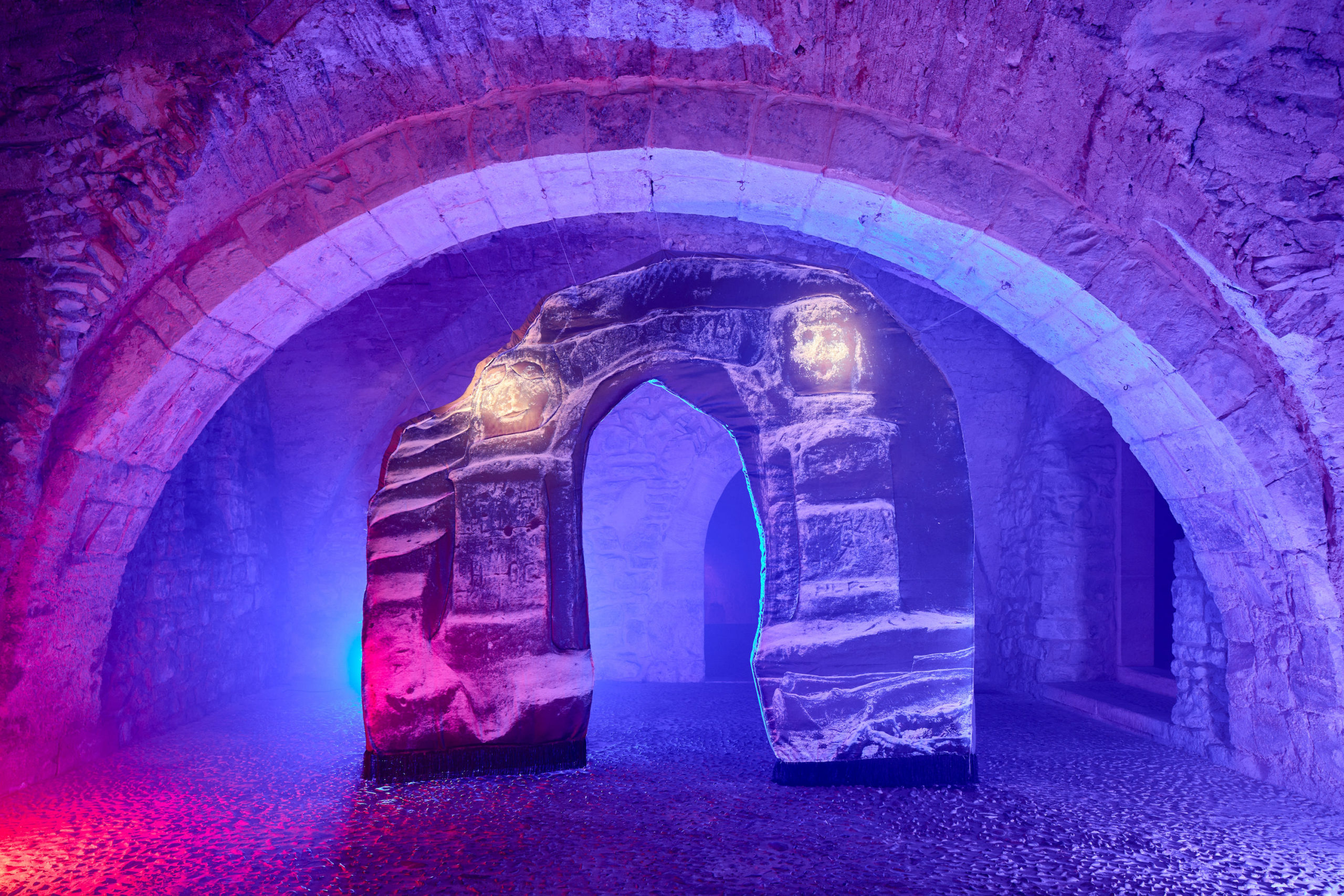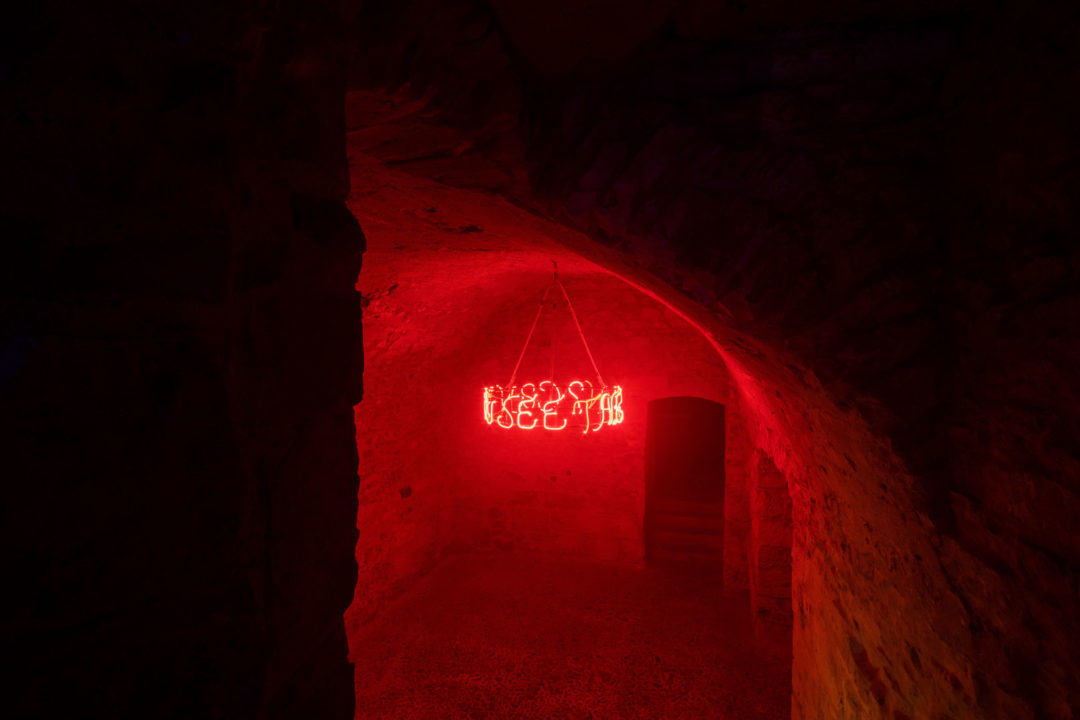Radek Brousil at Stone Bell House, Prague

Radek Brousil, “Can You Still Feel the Butterflies?”
8. 11. 2023 – 18. 2. 2024
Curator: Sandra Baborovská
Stone Bell House, Prague City Gallery (GHMP)
With the exhibition “Can You Still Feel the Butterflies?”, centered around the eponymous film, Radek Brousil orchestrates a crescendo of in situ installations, anticipating the viewing of the film itself.
The exhibition takes place in the medieval cellar of Prague City Gallery’s Stone Bell House, amplifying its visual impact through an unexpected background that takes the viewer out of the contemporary context. Each space contains an in situ installation that functions on its own but is also referenced in the film. It is impossible to determine which of the two, the film or the physical works, leave a greater impression, as they could exist independently yet mutually reinforce each other’s imprint on the viewer’s consciousness. Radek Brousil marvelously integrated the show in the raw space of the gothic, medieval cellar, without undermining its visual, historical, and contextual importance. All the while, his work maintains prominence without being overshadowed by the imposing setting.

The course of the exhibition is smartly set up in such a way that its progression inevitably guides the visitors through all the spaces and installations in anticipation to the final room where the video loops. Experiencing the works beforehand leaves a visual and emotional trace on the visitors, culminating with the film, which in turn, gives further meaning to the works and the exhibition overall.
Set in a contemporary urban environment, the film follows the main character, dressed in a flamboyant, yet ragged costume of a fish – dubbed the “half-dead fish” by Radek Brousil. And like a fish outside of water, the character feels incongruous amidst the dystopian, deteriorating modernism covered in graffiti tags. Embarking on an initiatory journey, the protagonist finds himself in another space, where he holds a conversation with an otherworldly figure. Their interaction describes their opposing views on the state of the world and seems at first as an intergenerational debate. She reminds him of the essence of nature “Can you still feel the butterflies?”, “Can you still see the sun?” and tells him that guilt and shame – flying shame, eating shame, shopping shame – will always be there. The fish replies that he feels “no shame, no guilt”, doing his best in the world he lives in. As the film unfolds, it becomes apparent that the two characters are in fact each other’s alter egos: the ethereal, Pierrot-like woman juxtaposed against the patchwork-clad Harlequin-esque half-dead fish. Their dialogue delves into themes of morality and existential reflection, yet no outcome is found. It all rather sounds like a poetic, metaphorical discussion about the inevitability of the end of the world.
Throughout the entire duration of the film we can read the motif of duality, or otherness: the character and his surroundings, his general condition alternating in between being energetic, skating and running, but also appearing as a passive, apathetic figure, sliding off stairs or into the skating pit, as well as his journey from one world to another, or yet again, Harlequin and Pierrot.
Nonetheless, the character manages to reconcile and integrate the two opposing sides within himself. This reconciliation was perhaps his original condition, for he is the half-dead, and hence, half-alive fish.
The artist conceived the in situ installations with works directly or indirectly referencing the film. For example, the many fabrics one sees in the first room which compose the work “I know how guilty one can feel” are seen in the film in a larger scale, composing the throne of the Pierrot character. On its own, however, this work speaks of the abusive appropriation of the African wax fabric industry by the old world. Denouncing present-day colonial attitudes, Brousil criticises a local Czech company, that sells cheaply produced fabrics well below ancestral traditional standards back to African countries at a fraction of the price of the originals. In the second room, we see a gate made of cloth yet representing a stone construction “I don’t know if anything at all will be all right”, as a reference to two important sculptural groups: the colossal 9-meter-high “Devils Heads”, which appears also at the end of the film, and the man-made caves at Klácelka. These works were carved into rock by Vaclav Levy, lesser-known today, yet one of the proponents of Czech modernist art already in the mid-19th century.

Radek Brousil skilfully aligns the atmosphere of the film’s surroundings, — a concrete jungle at first, later transformed into a surreal background showing impressive glass cupolas and giant forest sculptures — with the underground space of a 14th-century cellar. The use of colored light, both in the scenography of the exhibition and within the film itself, saturates the setting with a phantasmagorical ambiance. This lingering feeling of nostalgia creeps up, especially upon realizing that most of the film’s dialogue and musical score is inspired by early 2000s emo songs.
In the end, the most important aspect that will align the viewers with a work of art is honesty. “Can you still feel the butterflies?” perspires with raw candour, showing intimate details from the artist’s past and environment, as well as encapsulating the era in which he and we live today.
______________________________________________________________________________
Head image : Radek Brousil, I don’t know if anything at all will be all right, 2023 – Sublimation print on fabric, patched fabrics. Photo : Jan Kolsky
- From the issue: 107
- Share: ,
- By the same author: Streaming from our eyes, Déborah Bron & Camille Sevez, Sanam Khatibi, Ho Tzu Nyen, GESTE Paris,
Related articles
Performa Biennial, NYC
by Caroline Ferreira
Camille Llobet
by Guillaume Lasserre
Thomias Radin
by Caroline Ferreira